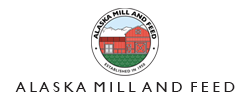Canine Nutrition 101 | Alaska Mill & Feed
Posted by Kimberly McCourtney on Dec 4th 2020
Diet and nutrition affect every aspect of your pet's life: from nutrition essentials, to feeding basics, to your pet’s social life.
NUTRITION BASICS
Necessary Nutrients
A dog's nutritional health depends on receiving the correct amounts and proportions of nutrients from the six required groups: water, protein, fat, carbohydrate, minerals and vitamins. With the exception of water, commercial dog foods identified as 100% complete and balanced contain all of these required nutrients.
Water
Water is essential in helping regulate body temperature, lubrication of body
tissues and as a fluid medium for the blood and lymph systems. Because water is
involved in practically every reaction within an animal's body, any large
deviation will be associated with adverse effects. A dog's body, therefore, has
several systems designed to maintain constant water balance.
Water intake is controlled by thirst, hunger, metabolic activity (work, gestation, lactation, growth), and the environment (humidity and temperature).
Dogs obtain water from the water they drink, fluid ingested with food, and water generated from metabolic processes in the body.
Water is lost in urine, feces, respiration, and to a small extent in flakes of skin, saliva, and nasal secretions. For nursing females, water will also be required for milk production.
A dog's water requirement is determined in large part by the amount of food they consume each day. A general guideline is that dogs require 1 ml of water for each kcal of energy.
Energy is measured in calories and a calorie is defined as the amount of heat required to raise the temperature of one gram of water from 14.5 degrees Celsius to 15.5 degrees Celsius. Because this amount of heat is so small, it is common to describe energy requirements and the energy content of foods in kilocalories (1000 calories = 1 kcal). The term Calorie, written with a capital C, is often used to refer to the amount of energy in 1 kilocalorie of food.
Food and Water Consumption
As food intake increases, a dog's water intake also increases. When the water
content of a diet increases, the dog usually drinks less water. Therefore, dogs
consuming canned diets, which contain approximately 70-75% water, will
generally drink less water than dogs consuming dry diets, which contain about
8-12% water.

